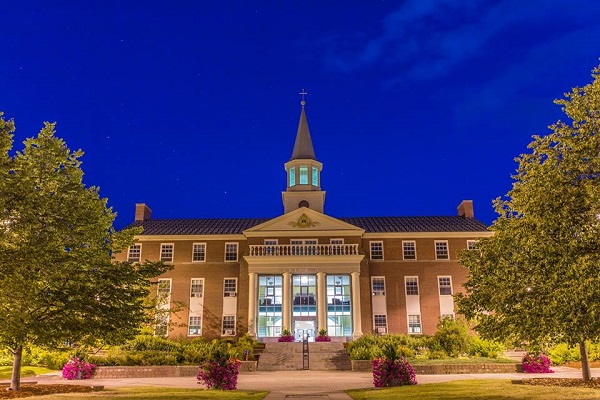
‘Nobody wants to be cold and in the dark’: Daylight Saving Time affect university students
News
Brianna Lyttle
Nov 24, 2025

Student struggles after STU replaces peer tutoring with Smart Start Study program
Features
Suzanne Shah
Nov 24, 2025

STU Fine Arts gains award-winning instructor Zachary Greer
Arts
Brianna Lyttle
Nov 24, 2025

Long-time Reds wrestling head coach to be inducted into New Brunswick Sports Hall of Fame
Sports
Liam Carleton
Nov 24, 2025
NEWS

Echoes of extremes: How labels influence political debate
News
Jennifer William
Nov 24, 2025
Political labels such as “socialist” and “fascist” are seen as divisive among students, but they also fue...

Explainer: 'Buy Canadian', what Ottawa’s new policy means for young entrepreneurs
News
Polina Kozlova
Nov 24, 2025
“Buy Canadian Instead” sign stands among liquor displays in a Vancouver store, part of a federal push to ...

STU community supports Caribbean students after hurricane
News
Jennifer William
Nov 10, 2025
Sochane Campbell, vice president of student life, helped organize the Jamaican Cookout fundraiser (Jenni...

Explainer: Ceasefire negotiations continue as Hamas refuses to surrender
News
Polina Kozlova
Nov 10, 2025
Global leaders support ceasefire negotiations for the war in Gaza. (Credit: Arab News) As new ceasefire n...

Western leaders back Trump’s ceasefire proposal, raises questions over Ukraine’s territorial future
News
Polina Kozlova
Nov 10, 2025
Western leaders call for an immediate halt to the war in Ukraine, even if this might benefit Russia. (Cre...

Students protest Starbucks on campus, call for local sustainability
News
Jennifer William
Nov 3, 2025
STU students hold signs in support of the environment and the Fredericton community in front of George Ma...
COMMENTARY

Commentary: Smriti Mandhana’s century proves women’s cricket is the future
Commentary
Suzanne Shah
Sep 22, 2025

Commentary: Fredericton nodes need work
Commentary
Mar 3, 2025

Commentary: ‘Seeing is no longer believing’ — thoughts on AI generated content
Commentary
Feb 17, 2025

Commentary: Is football being taken over by institutions?
Commentary
Nov 25, 2024
SPORTS

Saskatchewan Roughriders defeat the Montreal Alouettes to capture fifth Grey Cup
Sports
Leo Czank
Nov 24, 2025
The Saskatchewan Roughriders celebrate with the Grey Cup trophy after defeating the Montreal Alouettes 28...

Leo’s Hockey Report: Multiple players falling victim to unusual injuries this season
Sports
Leo Czank
Nov 24, 2025
New Jersey Devils forward Jack Hughes during a game against Philadelphia last January. (Credit: Noah K. M...

New Brunswick wins gold for first time in 18 years at 2025 Canadian Mixed Curling Championship
Sports
Liam Carleton
Nov 24, 2025
New Brunswick's Team Rene Comeau with the championship trophy. (Submitted: Rene Comeau) On Nov. 8, a Fred...

Tommies see strongest cross country season in years, send three runners to nationals
Sports
Liam Carleton
Nov 10, 2025
STU runner Kensea Aaron participated in a cross country meet on Sept. 27. (Credit: STU Athletics) Both th...

Blue Jays fans reflect on an improbable World Series run
Sports
Leo Czank
Nov 10, 2025
Blue Jays' Vladimir Guerrero flips his bat after hitting a home-run in game 4 of the World Series. (Credi...
ARTS

'Christmas tree is already up and the nutcracker is here': Gallery 78 opens newest winter exhibitions
Arts
Malachi Lefurgey
Nov 24, 2025
The opening night and reception of Gallery 78’s newest exhibition with a full crowd of supporters (Malach...

Magic and midwinter sonder: Black Box opens ‘Almost, Maine’ at STU
Arts
Jennifer William
Nov 24, 2025
St. Thomas University’s Black Box Theatre, located in James Dunne Hall, is where hopes and dreams are per...

Tony’s Music Box closes after 50 years, leaving a mark on the city
Arts
Nov 10, 2025
Tony’s Music Box is a family-owned business that opened in 1975. (Malachi Lefurgey/AQ) After two generati...

Illuminating loss and love: STU’s Day of the Dead altar brings people together
Arts
Jennifer William
Nov 10, 2025
Day of the Dead altar in James Dunn Hall, honouring those students who have lost loved ones. (Jennifer Wi...

Late-night double-feature: Rocky Horror stars STU students and Broadway talent
Arts
Brianna Lyttle
Nov 10, 2025
The Rocky Horror Show makes another appearance at The Playhouse. (Brianna Lyttle/AQ) When Tony and Courtn...

Silver Wave Film Festival celebrates their 25th anniversary
Arts
Malachi Lefurgey and Josh Eidt
Nov 10, 2025
The Silver Wave Film Festival started at the gallery on Queen before moving to Tilley Hall. (Photo Credit...
FEATURES

STU students witness a rare Northern Lights display in N.B.
Features
Nov 24, 2025
Green and red aurora bands break through the clouds, illuminating a quiet Fredericton neighbourhood. (Cre...

Photo Essay: Fredericton turns to Fall
Features
Suzanne Shah
Nov 24, 2025
A single tree becomes a season’s announcement. (Photo credit: Huzaifa Hameed) Fredericton doesn’t ju...

How Fredericton’s knowledge industry enables healthcare transformation
Features
Emilia Alvear
Nov 24, 2025
The Fredericton Chamber of Commerce, in partnership with St. Thomas University, delivered Fredericton's H...

STUISA brings students together for Islamic Relief Canada fundraiser
Features
Brianna Lyttle
Nov 10, 2025
Attendees play a round of Mario Kart during the Bridges of Hope fundraiser, which featured video games, c...

Therapy dogs bring comfort to campus during midterm season
Features
Nov 10, 2025
Lori Neily and Crème Brûlée, therapy Labradors, pose with their trainers, Zahra and Steve Neily, during t...
